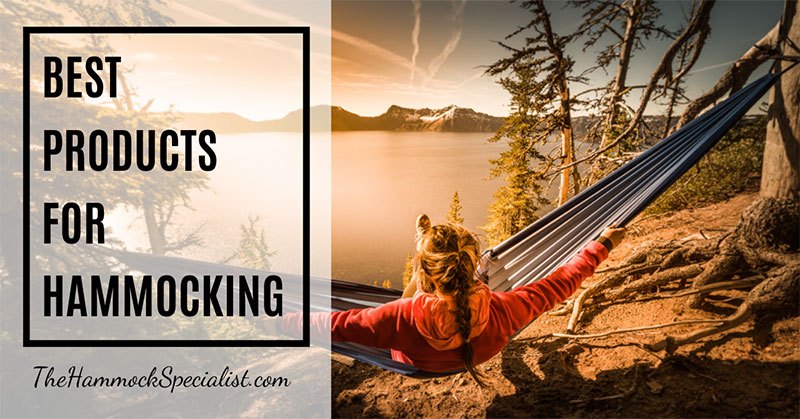Hammock camping is a surprisingly comfortable, lightweight, and insanely fun alternative to the traditional tent camping experience.
However, it’s not uncommon for newbies to be intimated by the mere idea of sleeping in mid-air, suspended between two trees. We get it; it’s a bit farfetched of a concept.
Where do you even start?
Hammock camping requires a whole different list of equipment and accessories than tent camping. And then there’s the set-everything-up part. And let’s face it – finding yourself out in the wilderness with no idea how to set your hammock up is as far from a good idea as it gets.
That’s why we’re here! Our detailed guide will explain everything – from selecting the best products for hammocking to setting everything up properly for a comfortable experience!
Hammock Camping 101: The Ultimate Hammock Camping Gear Checklist
If there's one thing that has the potential to ruin a perfectly fun camping trip, it’s forgetting to bring essential equipment with you.
We’ve heard stories about people leaving suspension systems at home and even completely overlooking the broad range of accessories designed to make hammock camping more enjoyable.
That’s why we figured it would be an excellent idea to start this round-up of the best products for hammocking with an overview of all the gear you’ll need to have on you for a comfortable – and safe – trip. We added a few highly recommended products in there as a bonus!
Here’s what a hammock camping gear checklist looks like – be sure to consult it every time before you head out the door!
The Essentials
Recommended Hammock Tarps
Our Suggestions
How To Set Up A Hammock: The Only Guide You’ll Ever Need
So, you finally did it. You decided to check out what all the hype is about, and you went and bought a camping hammock.
But how do you set it up?
Whether you’re an expert camper or a newbie, if this is your first time going hammock camping, the chances are that you’ll need a little guidance.
Here’s the good news:
It’s a surprisingly straightforward thing to do – especially when compared to the frustrating process of setting up a tent. Once you get the hammocking basics down, everything else will be a piece of cake!
Read through our handy hammock setup guides, and you’ll be a real hammocking expert in no time!
Hammocking 101: Three Steps to Setting Up a Hammock

There are quite a few ways to set up your hammock, and we’ll be sure to address all of them in the future. Right now, we’d like you to focus on remembering the three critical steps to setting up a hammock correctly.
1. Find Anchor Points
The first thing we'd recommend you to do as soon as you arrive at your camping spot is to inspect the area and look for two strong anchor points. For safety purposes, you must choose trees that are thick, healthy, and resilient enough to support your weight.
Another factor you have to consider is the distance between the two selected trees. You need to have enough space to find a comfortable angle and customize your setup later on in the process. Although it mostly depends on the size of the hammock, the general rule is that the trees should be between 10 and 15 feet apart from each other.
2. Fix Anchor Points
Now that you’ve picked your anchor points, the next step towards creating a camping network is to fix them. That’s where the suspension system or support belts come in:
Set the straps around each tree trunk right around eye level, allowing it to sit closer to the support system. If you’re camping on uneven or hilly terrain, be sure to check if the hammock is hung between the two trees evenly and at the same relative height. Take your time with fixing these anchor points – better safe than sorry.
We have a funny rule for determining the appropriate height placement:
Only go as high as you’re ready to fall.
3. Set Up Your Hammock
Once you have the two support straps firmly in place, it’s time to get to the fun part – setting up your hammock and connecting it to the support system.
There are two ways to go about it, depending on the actual model of the hammock. Some have to have the support system attached separately, while others come with a support system that’s integrated into the mesh.
That means that you can either tie the hammock to the straps directly through a carabiner or connect carabiners to the net and then to their respective bands. Whatever you choose as your configuration style of choice, make sure to leave a little sag to it, and aim to have the hammock at a 30-degree angle to the tree trunk.
Congratulations! You just managed to set up your first hammock successfully! Now that you have the basics down, the rest of your equipment should be relatively easy to configure.
Essential Hammocking Tips & Tricks for the Most Comfortable Camping Experience Ever

Did you think that we were going to wrap things up without sharing some vital tips and tricks for successful hammock camping with you? Guess again!
Use these tips to improve your setup and take things to the next level – and be sure to come back for more. This list will never stop growing:
Final Word
There are a few critical components to a successful hammock camping trip – and finding the best products for hammocking is undoubtedly one of them.
It doesn’t stop there, though. Picking the best equipment is only part of the equation. You’ll need to figure out how to set everything up correctly, as well. And while hammocks are designed to be easy to set up, you’ll probably need some expert guidance for the first few runs.
That’s why we’re here!
From showing you how to choose the best hammock camping gear to teaching you how to use it, we’re dedicated to helping you have the best, most relaxing camping experience of your life.
Read more —


